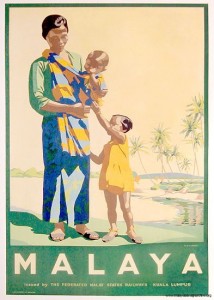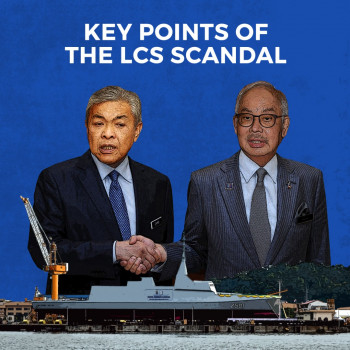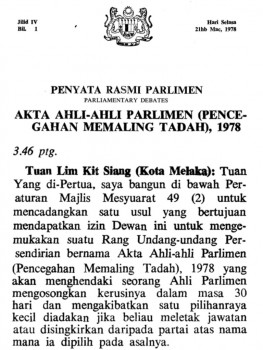by Wan Hamidi Hamid
There is an important period of our country’s history that is conveniently left out in the history books being taught in the last three decades. Perhaps these historical facts are not in line with UMNO-Barisan Nasional’s perception of history.
The seeds of independence were sown long before 1957 with many players of different backgrounds, ethnicity and ideologies. Conscious efforts to gain independence began in the 1930s although only after the Second World War (1939-45), serious struggles began to develop.
This is also an important period of our country’s history that is conveniently left out in the history books being taught in the last three decades. Perhaps these historical facts are not in line with UMNO-Barisan Nasional’s perception of history.
There are views that the roots of nationalism and seeds of independence began as early as the late 19th century, especially after the Pangkor Treaty of 1974, perceived by many historians as an official intervention of the British power in this country. Resentments over the meddling of British officials were felt by many local Malay elites, those close to the Rulers.
Within context, issues of nationalism and independence has a very strong reference to Malay nationalism. The Pasir Salak incident The 1875 Pasir Salak incident is now immortalised as an important root of Malay nationalism. It was a case of a local warlord Datuk Maharajalela who hired an Orang Asli to murder Perak British resident J.W.W Birch for imposing British-style taxation and collection of local produce against traditional customs.
The incident is portrayed as the Malays fighting against British oppression and intervention, although the manner of the murder was quite embarassing, as Birch was assassinated when he was taking a bath. The more serious issue is that Birch, according to historians, was trying to impose the British-originated Slavery Abolition Act; putting an end to all practices of slavery.
The popular version nowadays is that the British resident was trying to outlaw “adat hamba utang” (the custom of debt slavery) which is a common practice not only in the Peninsula but also many parts of Indonesia, where people who failed to settle their debt on time had to serve their money lenders by being servants of the house.
The problem is, there was another form of slavery that was also common in Perak, the Western-style slavery. It did not involve the Malays but rather the buying and selling of Orang Asli. Birch also tried to abolish this kind of slavery.
The British and the Malay elites
Other attempts to relate the fight for freedom during the 19th century to the actual struggle for independence in the 1940s were also vague in the sense that the Malay world then was so segregated and isolated, and were mostly focused on the Rulers or their representatives’ squabbles with the British officials.
Input from the ordinary folks were mostly neglected, except as foot soldiers. In this respect, the seeds of modern nationalism that paved the way towards independence could be discussed within the context of a modern nation state. This should begin in the early 20th century, or to be exact after 1919 when the entire Peninsula was under the British administration, although not actually total colonial rule.
The Rulers have the official powers, especially in the extremely sensitive areas such as religion and local customs, and protected by the British. The feudalistic structure of the Malay society meant that only the elites were properly schooled by the British, and although the administrators provided schools for ordinary folks of all races, including the children of Chinese and Indian migrant labourers, it was the Malay elites that were prepared jobs in the colonial administration.
While not all the children of the elites were happy with the arrangement, it was the secular Malay-educated students who showed inclination toward nationalism. While the home ground was Tanah Melayu, the influence was from overseas – Dutch East Indies, or as we know it now, Indonesia.
The Dutch-trained Indonesians with the pondok-schooled students made an uneasy alliance to continue the struggle to oust the Dutch colonial masters. Malaya – truly Asian nationalism Throughout the 1920s and 1930s, some of the fighters and propagandists had been coming in and out of British Malaya, and some of them made friends with the Malays in Sultan Idris Teachers’ College and other similar-minded idealists.
The seeds were slowly being sown. To put the situation in context however, of those migrant labourers, not all were in British Malaya to become labourers during the 19th century. Some were political fugitives in their motherland especially the Chinese. They brought with them political groups opposed to the Manchu rulers, in the form of secret societies, and were involved with businesses, quarrels and even battles among themselves.
That led to the intervention, and at times, collaboration with the Malay warlords. By the early 19th century, Malaya had become one of the transit points of Chinese political recruiters and exiles. Kuomintang, with close relations with the British, made their way to Malaya to organise campaigns to free China from foreign domination, especially that of Japan, which by then had began to stretch its imperialist arms over China.
That is to say many Chinese were political back then, but it had nothing to do with freeing Malaya from British administration. The Indians too were largely influenced with Indian nationalism. In short, no one was interested in fighting for Malayan independence.
Communism – Malayan independence or soviet republic?
Although there are views that the communists in Malaya were among the first to proclaim independence, they had a different kind of idea. Possibly the first political party to be formed in British Malaya in 1930, although the setting up was sanctioned by its international body and Vietnamese communist leader Ho Chin Minh was here to see the launch, the Communist Party of Malaya was interested in ousting the British to replace it with a Soviet republic.
A Soviet republic – based on Lenin’s Russia, and later Stalin’s dictatorship – is a one-party system ruled by a committee of a dozen people who dictate the political, economic and social life of a country based on Lenin’s and Stalin’s interpretation of communism – any other form of ideologies were basically enemies of the state.
It was such an ideology that CPM was fighting for Malaya, before and after the Second World War. Basically it was Asian nationalism that was flourishing in British Malaysia during the 1920s and 1930s, albeit separately, with the Indians too split between the ideologies of India’s Congress Party and its opponents including the then popular movement of fascism and communism.
Sepuluh Tahun Sebelum Merdeka from fahmi reza on Vimeo.
Malayans and the spirit of Merdeka
The Malays too began to feel the infusion of nationalist fervour, although it was not about the independence of Malaya but rather the goal of Indonesia Raya or Melayu Raya, the Greater Indonesia. Kesatuan Melayu Muda was recognised as the first homegrown political party formed by the Malay nationalists, mostly school teachers.
The Japanese invasion in 1941 halted the progress with many different nationalists fought on different sides. While some of the Malay nationalists collaborated with the Japanese, others fought with British including the communists, who hated the Japanese more than the British, a continuation of their war in China. No Chinese, either those with the Kuomintang or CPM, could ever forgive the Japanese imperialists for the 1937 Nanjing massacre.
In retrospect, the real move towards independence actually began immediately after 1945, in particular when the war experience reflected the British inability to defend its empire, and its defeat to an Asian military might. It is also part of the European decolonisation process that was taking place after the war.




